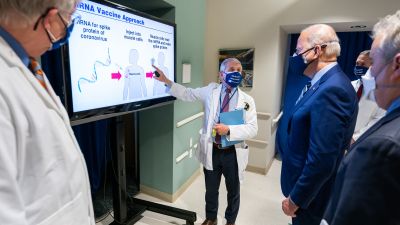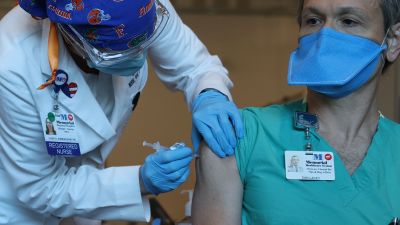
HOLLYWOOD, FLORIDA - AUGUST 07: RN Jose Muniz prepares a COVID-19 vaccination at Research Centers of America on August 07, 2020 in Hollywood, Florida. Research Centers of America is currently conducting COVID-19 vaccine trials, implemented under the federal government's Operation Warp Speed program. The center is recruiting volunteers to participate in the clinical trials, working with the Federal Government and major Pharmaceutical Companies, that are racing to develop a vaccine to potentially prevent COVID-19. (Photo by Joe Raedle/Getty Images)
First Response
The day that the COVID-19 vaccines are approved for emergency use by the FDA — likely December 11, based on the timing of their meeting s— will be a great triumph for science and public investment. The Moderna and Pfizer vaccines, for the first time based on messenger RNA, herald a new scientific breakthrough that could unlock a host of new therapies and palliatives. (AstraZeneca’s vaccine, which announced some positive results today, could also be approved in short order.) And the rapid timing from discovery of the virus to a vaccine, pushed along by public dollars and guarantees, should also become a model, though if we collaborated with the world instead of going it alone we would have dispensed the vaccine even faster and saved a lot of lives.
But these innovations, which will have wide-ranging effects into the future, collide with the near-term block and tackle of how you get a drug manufactured, stored, and shipped to every corner of the globe, to be administered, twice, to virtually everyone on the planet. At some point the science gives way to a logistics operation on a scale nobody has ever seen before. Compounding this difficulty is the fact that Joe Biden’s transition has no access to the vaccine data and is frozen out from the decision-making process.
The infrastructure we currently have for vaccine distribution is by definition weak, because the scale of what’s needed with this is so massive. The Vaccine for Children program provides something like 3 million shots a year. We need 600 million in a matter of a few months, just for the US And the big, glaring problem is that, in our federal system, the primary role in actually getting the vaccine delivered to people goes to states and localities. And incredibly, there’s practically no money for this purpose right now.f
Here is how this has been explained to me. There are 64 “jurisdictional immunization programs,” which includes 50 states, D.C., eight US territories, and five large cities. They ask for an allocation and the government, through Operation Warp Speed, will fill that. But at that point it’s up to the jurisdictions to determine vaccination sites, transport the vaccine to those locations, and make sure there’s enough demand at each particular site so the vaccine doesn’t go to waste. Pfizer’s vaccine in particular has a short shelf life, just five days in a refrigerator, so it has to get out immediately once it reaches the last leg of the journey.
There’s also prioritization for who gets the initial supply of shots, staffing for how administers them and how the health system can integrate it, and just a mountain of other details. We already know about the freezers; many locations just don’t have this capability.
So how much money has been allocated for this, the largest logistical project in the history of mankind? $200 million. That’s all the jurisdictions have received thus far. Biden has promised $25 billion for vaccine distribution, but that’s tied up in the moribund stimulus talks. There may be some smart person devising some way to unlock emergency funding along the lines of what Trump did on the border wall, but at the moment, you need Congress to issue some dollars. “[W]e absolutely do not have enough to pull this off successfully,” said the state health officer of Mississippi to the New York Times.
This is absolute madness. The economic and public health effects of efficient delivery of a vaccine are almost incalculable. It will unleash pent-up demand across the country and return the country to something resembling normalcy. This multi-trillion-dollar, multi-tens-of-thousand-life action is resting on a couple hundred million distributed across the country? What?
This case study of preparations in my home county, Los Angeles, is instructive. They’ve bought the ultra-cold freezers, which is more than a lot of places can manage. But there aren’t any plans on how to ship the vaccine from one freezer to another. The decisions on where to distribute the vaccine haven’t been made. All of these decisions cost money, and making the wrong one and having to change plans cost more money. That money doesn’t exist without federal assistance.
As Olivia Webb reports, with states largely unable to act, HHS is going through CVS and Walgreens to deliver to long-term care facilities. Other large chain pharmacy partnerships are being put in motion. Distribution, in other words, is being privatized. “There are huge potential failure points,” Webb notes, common to the idea that scale can magnify disruptions. If one of the thousands of little nodes in the jurisdictions have a refrigeration problem, that can be managed with some other part of the network. If CVS fails, that could affect a much larger population.
Of course, this is just the national response. Global vaccine distribution is a whole other can of worms, one that’s incredibly necessary to prevent future outbreaks and mutations. There’s a global consortium called Covax that is dedicated to this task, but this Times takeout on Bill Gates’ role with the organization and the use of a bunch of McKinsey consultants is not very satisfying. In particular, the lingering effects of drug company intellectual property fights hangs over the whole enterprise.
In the immediate term, cities and states have to have the funding to distribute the vaccine. Otherwise, this gets wrapped up with big business in ways that could have disastrous effects on global health.
Look at Me
I was on Dead Pundits Society talking about the Day One Agenda. Listen here.
I was on The Intercept’s Deconstructed podcast, also talking about the Day One Agenda. Listen here.
Days Without a Bailout Oversight Chair
241.
Today I Learned
- Fed chair Jerome Powell has (I think, it’s ambiguous) agreed to give back most funding for credit programs to the Treasury. (Federal Reserve)
- Up to 325,000 excess deaths this year, well above the official coronavirus mortality statistics. (New York Times)
- Hong Kong giving $645 to anyone who tests positive for coronavirus, to encourage testing. (Bloomberg)
- The monoclonal antibodies from Regeneron that President Trump used got FDA authorization. (CNBC)
- Incredible: 20 percent of downtown businesses in Madison, Wisconsin have closed up due to the virus impact. (WKOW)
- Sen. Kelly Loeffler (R-GA), who has her own runoff election in Georgia to campaign for, is in quarantine after inconclusive COVID tests. (Axios)
- $15 billion in direct bailout support for the fossil fuel industry, according to a new report. (Bailout Watch)
- Racial disparities on COVID are the consequence of existing health disparities, and can be overcome with effort. (Mother Jones)
- Plenty of ventilators but not enough people who know how to use them. (New York Times)



